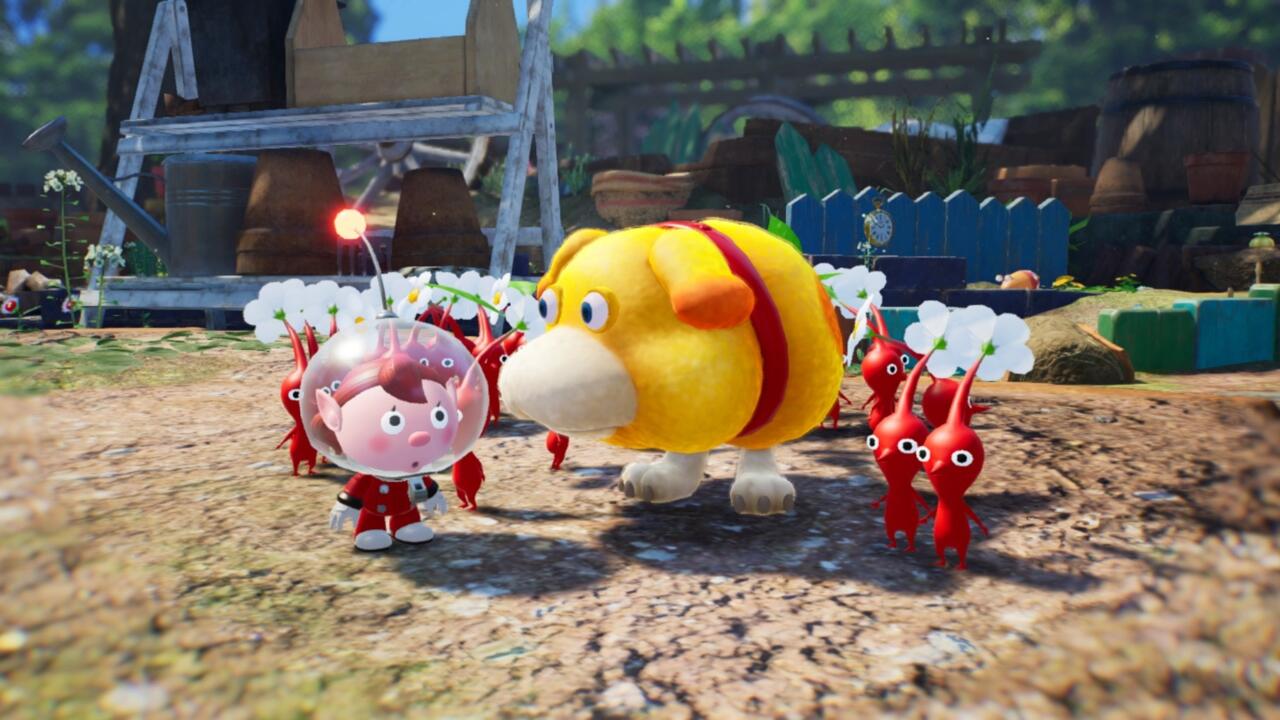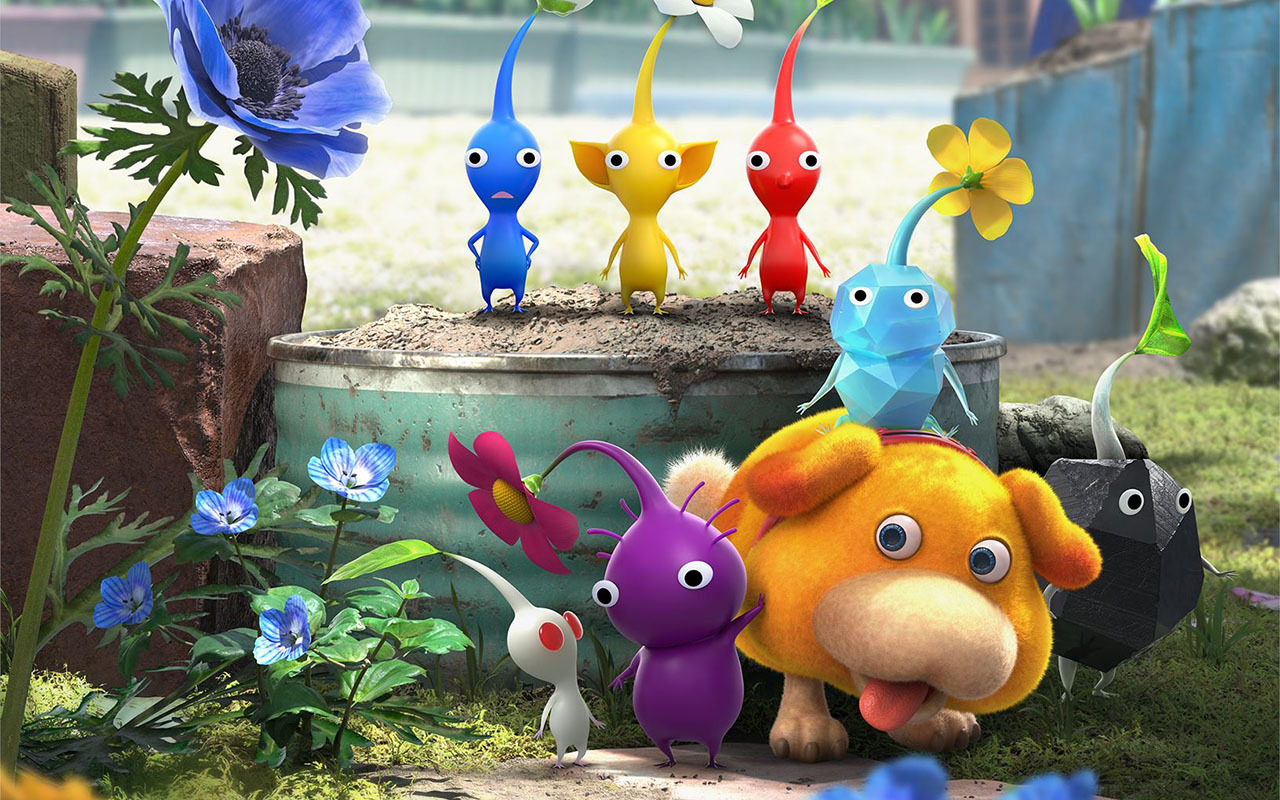One of the most prominent apps on my phone is a simple to-do list app. I have a handful of recurring tasks every month or year, along with whatever I jot down as a reminder. It took me more than 20 hours with Pikmin 4 before I identified that the sensation it evoked was the same as that of completing my to-do list. Pikmin 4 is a game, sure, but it’s also a sort of low-impact activity that gives you the same satisfaction of checking off a list of small, relatively simple tasks. That makes it pleasant to play, but that quality also makes it feel discordant when it briefly adds elements that provide a mild but noticeable degree of pressure–elements that make it more traditionally “game-like.” On the whole, I think I prefer Pikmin the activity to Pikmin the game.
Pikmin 4 is meant to be a welcoming entry point for first-timers. The effort to bring you into the world of Pikmin begins very literally, with a character creator that allows you to make your own Rescue Crew member. The tools weren’t robust enough to make a facsimile of me–very few beard options, for one thing–but I made a cute little man who I was proud of and wanted to see go on an adventure regardless. With my stubby adventurer fully formed, I was ready to explore the world of Pikmin.
For the uninitiated, that world is basically a suburban Earth-like backyard. While the diminutive characters never acknowledge it, it’s very clear from your surroundings that you’ve crash landed in a garden. Your surroundings might be checkered with gardening tools or mounds of dirt left by whoever occupied the home. There’s a playful sense of scale to the setting that recontextualizes common household objects as massive obstacles or helpful bridges. Sometimes, you fall into a steady rhythm of puzzle-solving and completely forget the nature of your surroundings, until you suddenly pull back and realize there was a giant metal pail or bag of sod just next to where you’ve been excavating.
Pikmin centers mostly around these environmental puzzles, as you guide your band of tiny plant-like Pikmin creatures around, seeking treasures and using their unique skills to traverse the world. A small puddle might seem like an impassable ocean to you and your Pikmin, but toss in a handful of Ice Pikmin and voila, the sea freezes up and you can cross it. Learning about each of the Pikmin’s strengths and using them efficiently is part of the relaxing, chore-like cadence of Pikmin 4.
The blue Ice Pikmin is one of the new types introduced in Pikmin 4, and as the fresh newcomer, it gets its fair share of attention with puzzles built around its unique attributes. Inversely, some returning Pikmin seem to get the short end of the stick with barely anything to do at all–the white, poison-resistant Pikmin and pink, flying Pikmin were treated like specialist classes, and barely used at all. Rock Pikmin, meanwhile, are hearty little creatures that make noticeably short work of walls, but they appear so late in the game that they aren’t as frequently used as they might have been. In fact, for most of my playtime, I stuck almost entirely with the same core team: an even distribution of red, yellow, and blue Pikmin.
Rounding out the regular cast of Pikmin is Oatchi, a two-legged dog-like creature. Unlike the Pikmin, which come along in different types and numbers, Oatchi is one-of-a-kind and your constant companion. It has the strength of multiple Pikmin, and you can split up to solve a puzzle. The best part about Oatchi, though, is that he’s a rideable mount. Shortly after you get him, he grows big enough for you to ride, so you can hop aboard and explore the stage more quickly. This also makes it easier to visualize where all your Pikmin are. It’s a little anxiety-inducing for me to have my Pikmin scattered loosely behind me, even if I know they’re supposed to follow. Having them all clinging to Oatchi’s fur (felt?) keeps them all together and tidy, and makes it very easy to visualize if one is lagging behind.
Keeping your Pikmin close at hand is important because they’re vulnerable, both to environmental hazards as well as the critters who roam around the garden. Unlike the gardening implements and backyard decor, these aren’t generally recognizable creatures. Most of the otherworldly animals will crush or swallow your Pikmin whole. You can always go back to the ship to gather more Pikmin, but I never liked losing the critters. Part of that is because the other characters in your earpiece mourn their loss, but I also just felt generally uncomfortable with losing a resource, even if it could be refreshed. Especially when encountering a new enemy, it would be easy to get caught up in a new attack pattern or trap that I hadn’t anticipated and lose a couple of Pikmin.
Oatchi is useful in battle as well–not only can he attack enemies, but charging into enemies flings all of your Pikmin onto an enemy en masse, much faster than you could reasonably fling the little buggers manually. Freezing a large enemy with Ice Pikmin, for example, would risk losing some while you fling them one at a time, but charging into them with Oatchi freezes them almost immediately. Between the added security of keeping my Pikmin close and the combat advantages, riding on Oatchi became my standard mode of playing the game. Others might prefer to treat him like a super-Pikmin, who can dig out and transport treasure faster than the average critter. And while it’s a small change, playing this way functionally looks and feels very different than a typical Pikmin game.
For the times that you absolutely can’t avoid losing Pikmin, there is now a new Rewind Time feature. Previous Pikmin games have offered a do-over at the end of the day, but Pikmin 4 expands the concept by regularly saving. You can’t manually save during a day, and it’s easy to see how that would be too exploitable, but the auto-saves typically happen every 2-5 minutes, so you never lose too much progress. For those who are very protective of their Pikmin, it’s a huge convenience feature to just rewind a few minutes and try an encounter again if you ran into trouble in the interim.
In the main exploration areas, which make up the bulk of the game, the Pikmin-tossing combat is incidental and mostly player-initiated. You can almost always keep your distance from a creature if you don’t feel adequately prepared, so you’re very rarely caught off-guard. Taking on enemies gets a much heavier emphasis in two new modes, which help break up the pacing with varying degrees of success.
The more Pikmin 4 leans into fashioning itself after a more traditional game, with competition and fail-states, the more prone it is to getting in its own way.
The first is the Night Missions, which take place after dark. These feature the new Glow Pikmin, and only Glow Pikmin, in a tower defense minigame. The presence of a glowing, nectar-like substance attracts and enrages the local fauna, but that nectar also happens to be a vital ingredient in your mission, so you have to protect the hive-like nests where it’s generated until morning comes. Only a handful of them are mission-critical, though you can go on many more if you’d like. These aren’t terribly difficult, but that feels intentional. The pace of Pikmin 4 is so relaxed that it would seem incoherent to have high-stress tower defense segments. While I’m sure they ramp up in difficulty if you want to do them all, it’s nice having an option to do something different that has the same deliberate cadence.
The same can’t be said for Dandori, the other new game type. Often you’ll find Leaflings–other explorers who have gone feral and have leaves covering their faces–and they’ll challenge you to Dandori. The game explains that Dandori is a Japanese concept referring to orderly planning and efficiency, and in practice, these come in two varieties. The first is a Dandori Challenge to beat a high score within a time limit, while the other is a competitive Dandori Battle where you gather treasures against an AI opponent. This one is directly competitive, as you can steal one another’s treasure and drop special items to disrupt their progress. Both flavors of Dandori felt at odds with the rest of the game. I didn’t struggle too much in either type, but I did sometimes have to retry after just barely running out of time. Pikmin 4 is so centered around taking things at your own pace, it’s strange having a game type that serves the exact opposite purpose.
The in-campaign Dandori Battles are obviously meant to train you for the game’s multiplayer mode, which is competitive Dandori against another human player. In fact, one of the very last story-required Dandori Battles introduced a new game mechanic, so it seemed clear that this was meant to serve as training wheels. Dandori against another human player may give the game legs, but I generally avoided playing these battles whenever possible in the campaign, and I can’t really imagine wanting to do it against another player. Competitive Pikmin is such an odd concept; even saying it aloud sounds wrong.
Pikmin 4 introduces a few other traditional game-like elements with more success. You can enhance Oatchi using the pup power granted by rescuing people, which lets you upgrade your canine companion with a stun power for its charge attack or the ability to withstand extreme cold. This gives you a welcome level of customization to use Oatchi as you like–in my case, I dumped everything into a few factors like speed and the charge attack and didn’t see much use in the other upgrades. The other upgrade path comes from equipment, which you can purchase using the raw materials you gather. Those raw materials are also used sometimes to build simple bridges or ramps, though, so I made sure to keep some in reserve. A handful of equipment types are permanent upgrades, like the vital ability to call all Pikmin back to your base, while others are temporary power-ups. As with the Pikmin, I didn’t want to waste my precious resources, so I used those sparingly (and sometimes, accidentally).

Captain Olimar is a major factor in the story, but he’s not the star. Instead, your mission is to find and rescue him, along with the first Rescue Crew dispatched to rescue Olimar, which also crashed. The distress signal sent out attracted a gold rush of other explorers and curious travelers, giving you plenty of hapless munchkins to rescue. Some turned into Leaflings that you need to challenge to Dandori to rescue, while others are just passed out at the hands of some strange bug-monster.
That story, like most of Pikmin 4, is gentle and unobtrusive. It’s all just very agreeable and sweet, and there’s a certain gratification that comes from directing your little army of plant-people to gather treasures like fruits and Game Boy Advance cartridges. The more Pikmin 4 leans into fashioning itself after a more traditional game, with competition and fail-states, the more prone it is to getting in its own way. Sometimes, it’s enough to simply have a relaxing activity.






